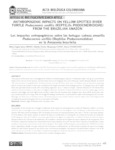Use este identificador para citar ou linkar para este item:
http://www.alice.cnptia.embrapa.br/alice/handle/doc/1049102Registro completo de metadados
| Campo DC | Valor | Idioma |
|---|---|---|
| dc.contributor.author | ARRAES, D. R. S. | pt_BR |
| dc.contributor.author | CUNHA, H. F. A. | pt_BR |
| dc.contributor.author | TAVARES-DIAS, M. | pt_BR |
| dc.date.accessioned | 2016-07-19T11:11:11Z | pt_BR |
| dc.date.available | 2016-07-19T11:11:11Z | pt_BR |
| dc.date.created | 2016-07-19 | pt_BR |
| dc.date.issued | 2016 | pt_BR |
| dc.identifier.citation | Acta Biológica Colombiana, v. 21, n. 2, p. 413-421, mayo-ago. 2016. | pt_BR |
| dc.identifier.uri | http://www.alice.cnptia.embrapa.br/alice/handle/doc/1049102 | pt_BR |
| dc.description | The purpuse of this study was to investigated the influence of anthropogenic impacts on Podocnemis unifilis nesting on a stretch from Falsino river, with two forest reserves, and one urban area on the Araguari river, state of Amapá, eastern Amazon (Brazil). A total of 180 nests were found, being 89.4 % in the forest reserves and only 10.6 % in urban areas. On Falsino river, we observed a spawning pattern, because the number of nests was correlated to the length and width of the nesting locations. On Araguari river, the P. unifilis nests were generally found in areas with surrounding vegetation up to 5 meters in height, minimum distance of 120 meters from residences and immediately or after places of higher exploration of pebbles. Females from Falsino river had smaller eggs, but the neonates were bigger and with higher body condition index than the neonates from Araguari river. About 80 % of the nests were prey, mostly because of the large collection of eggs for feeding. Furthermore, it was found that adult turtle hunting has been intense. Although one of the areas is in forest reserves, the human impacts were similar to those caused in urban areas, indicating the need to implement protection programs for the conservation of P. unifilis. | pt_BR |
| dc.language.iso | eng | eng |
| dc.rights | openAccess | eng |
| dc.subject | Turtle | pt_BR |
| dc.title | Anthropogenic impacts on yellow-spotted river turtle Podocnemis unifilis (Reptilia: Podocnemididae) from the Brazilian Amazon. | pt_BR |
| dc.type | Artigo de periódico | pt_BR |
| dc.date.updated | 2017-02-14T11:11:11Z | pt_BR |
| dc.subject.thesagro | Tartaruga | pt_BR |
| dc.subject.thesagro | Ovulação | pt_BR |
| dc.subject.thesagro | Ninho | pt_BR |
| dc.subject.nalthesaurus | Ovulation | pt_BR |
| dc.subject.nalthesaurus | Nests | pt_BR |
| riaa.ainfo.id | 1049102 | pt_BR |
| riaa.ainfo.lastupdate | 2017-02-14 | pt_BR |
| dc.contributor.institution | DÉBORA REGINA SANTOS ARRAES, UNIFAP; HELENILZA FERREIRA ALBUQUERQUE CUNHA, UNIFAP; MARCOS TAVARES-DIAS, CPAF-AP. | pt_BR |
| Aparece nas coleções: | Artigo em periódico indexado (CPAF-AP)  | |
Arquivos associados a este item:
| Arquivo | Descrição | Tamanho | Formato | |
|---|---|---|---|---|
| CPAFAP2016Anthropogenicimpactsonyellow.pdf | 728,09 kB | Adobe PDF |  Visualizar/Abrir |









